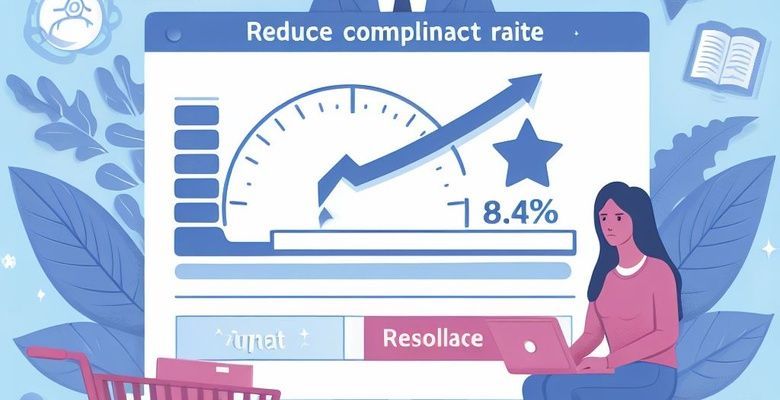Complaints can be quite burdensome for your company, both financially and in terms of time. And they may lead to dissatisfaction among your customers, which has a negative impact on customer loyalty. Here are some tips on how to reduce the number of complaints.
The calculation of the complaint rate
Firstly, create a solid basis of figures. To do this, you need to determine an important key figure - the complaint rate. The complaint rate is an indicator of the ratio of complaints to products sold. The formula for calculating is:
(number of complaints / number of orders) x 100 = complaint rate in per cent
It is important that you use the same time period for all factors in the calculation in order to obtain meaningful results.
For example:
(50 complaints in January / 5,000 sales in January) x 100 = 1 % complaint rate)
What is an acceptable complaint rate?
Regardless of whether you are an online retailer or run a physical shop: There are always dissatisfied customers. Therefore, complaints are not uncommon. However, the relative number of returns should remain within a certain range.
- A complaint rate of around one per cent is considered normal and acceptable.
- You should be careful with a complaint rate of up to three per cent.
- A complaint rate of over three per cent is considered problematic.
In other words, if your complaint rate is three, five or even ten per cent, you need to take immediate action to rectify the problem. Otherwise, your business could suffer lasting damage and jeopardise the stability of your company.
Measures against a high complaint rate
You have various options for reducing the complaint rate. For example these:
Always keep an eye on the figures
Always keep an eye on the complaint rate and calculate it regularly. Record the value for your entire range as well as for individual product categories and, if necessary, for individual products. This is the only way to get a well-founded overview of your situation.
Consider promotions separately
In the case of special promotions such as Black Friday sales or Christmas offers, you should carry out an additional calculation in order to recognise special effects immediately. .
Ask for reasons
Many companies are so accommodating that they do not ask for precise reasons for complaints. However, it is better to find out the reasons for a complaint - without badgering or harassing the customer. Ask about the reasons for the return or exchange in a conversation or via an online form.
Draw conclusions
Collect the reasons for complaints and analyse them. Bear in mind that some customers click on the first answer option provided on online forms out of convenience. Or that buyers are a little "mouthy" during a complaint dialogue or even give false reasons in order to settle the matter quickly.
Categorise feedback
Categorise the reasons for complaints, for example: "Difficult to use", "Technical defect", "Low quality", "Wrong expectation". This makes it easy for you to determine whether a new product is a so-called Monday production.
Consider the human factor
Also consider the interpersonal aspects. Some people are seduced by advertising campaigns and then soon realise that they don't need the product at all. Or perhaps your advertising has promised something that your product cannot fulfil. In case, the fault lies in your marketing measures.
Check your positioning
Analyse whether you are addressing the right target groups with your marketing measures and products. Perhaps you are selling inferior devices to clients that expects premium quality?
Mini checklist to reduce the complaint rate
☑️ Find the causes of complaints
☑️ Derive insights from this
☑️ Adapt your marketing strategy if necessary
☑️ Work continuously on improving your products and services
What you should do after a complaint
Dissatisfied or disgruntled customers can be problematic for your company. In the digital world, a bad reputation spreads quickly:
- Negative reviews can appear on platforms such as Google, Amazon and in your own online shop.
- Social media can be used to spread the word about your company, which in the worst case can lead to a shitstorm.
It is therefore important to act proactively! Try to "catch" dissatisfied customers immediately. Here are a few essential measures you should take: :
Friendliness when dealing with complaints
Remain friendly, even if a customer may be irascible or insulting. A polite approach can help to defuse the situation and find a solution.
Suggest solutions quickly
Offer solutions quickly. For example, if an appliance is faulty, you could offer a replacement or loaner appliance. This shows the disgruntled customer that you are willing to solve the problem.
Refund of the purchase price
Offer to refund the purchased product without hesitation. This can help to restore the customer's trust.
Compensation for dissatisfied customers
For extremely dissatisfied customers, you could offer a voucher or similar as compensation. This usually improves the customer relationship.
Responding to online reviews
Respond to online reviews as quickly as possible by thanking them for their feedback and offering a solution if necessary. This shows that you take your customers' feedback seriously.
Further measures
- Remove bad products from your range immediately!
- If your company is not the manufacturer, speak directly to the producer about the poor quality. You may want to consider changing suppliers.
- Train your customer support team regularly so that they apply the points mentioned here.
Summary
Take complaints seriously! Therefore, always keep an eye on the complaint rate and try to continuously reduce this important key figure. And also try to satisfy your customers. Ultimately, only a satisfied customer is a good customer. A customer who enjoys shopping with you and has few complaints.








